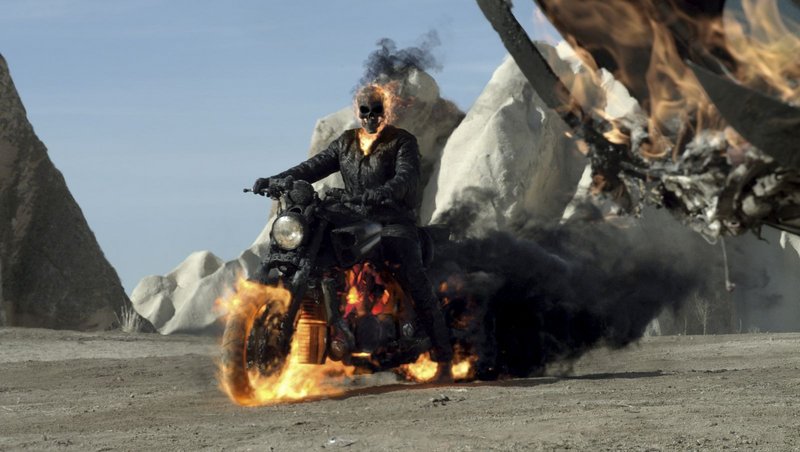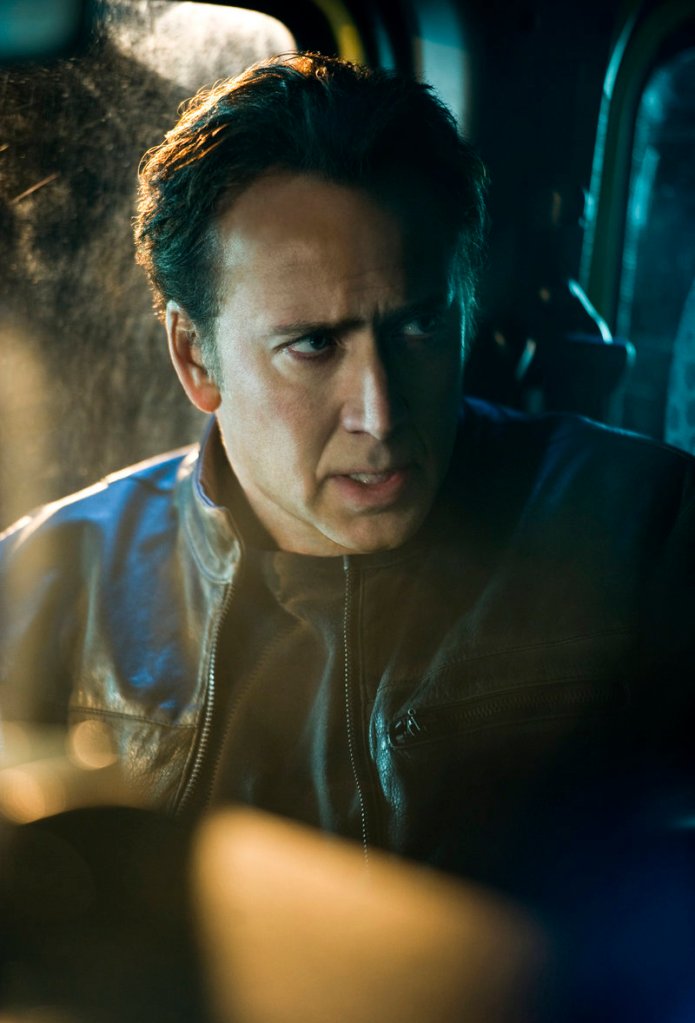In “Ghost Rider: Spirit of Vengeance,” Nicolas Cage punches Satan. He punches Satan in THE FACE.
Playing Ghost Rider, Cage also saves a little boy and helps people and does some other heroic stuff. But no matter what he does, the character will never be as beloved as Batman and Superman. Ghost Rider doesn’t get cheering crowds or parades. The character of Johnny Blaze — a motorcycle stuntman who turns into a flaming skeleton and sucks the souls out of people — isn’t even a superhero, really. He’s more of a man possessed, which is why the role suits Cage so well.
Unlike other upcoming Marvel Comics film adaptations such as “The Amazing Spider-Man” and “The Avengers,” which are due in the summer accompanied by an avalanche of hype, “Spirit of Vengeance” rode into theaters Friday, in the middle of winter, without screening in advance for critics. That’s the same stealth approach Columbia Pictures used when they released the first “Ghost Rider” film in 2007. The reviews, when they appeared, were scathing. On the Internet, where geek culture reigns supreme, the movie was heartily ridiculed.
But “Ghost Rider” earned $228 million worldwide. That was enough to convince Cage — a diehard comic-book fan who named his son Kal-El, was once set to play Superman for director Tim Burton and appeared in the superhero satire “Kick-Ass” as the proud papa of a 12-year-old assassin — to give the role another shot.
“Spirit of Vengeance” was directed by the filmmaking duo of Mark Neveldine and Brian Taylor (“Crank,” “Gamer”) in their usual breakneck, I-can’t-believe-what-I-just-saw style. The movie boasts some sensational 3-D effects, nifty nightmarish imagery and a curious sense of humor — not quite camp, but definitely in the same neighborhood. Early in the film, for example, there’s a scene in which an injured Blaze tries to convince a hospital nurse to give him some morphine. He explains that he transformed into a monster the night before. She assumes he’s nuts. “No, man, I’m not hallucinating!” Blaze shouts at her in a blast of unhinged lunacy. “Look, I’m flirting with you!”
Cage’s face lights up when you bring up that line. It’s a throwaway moment in a movie packed with gigantic action set pieces, elaborate chases, Satan worshippers and tattooed monks. But the scene is also the kind of small, bizarre beat Cage grooves on.
“I find it incredibly funny when guys, in the presence of a lady, refer to them as ‘man,’ ” the actor says. “It’s just wrong. In that scene, Johnny Blaze is recovering from the pretty serious hangover of having his head erupt into a flaming skull. That’s just free rein for me to try stuff. I wanted Blaze’s humor to be a lot darker and edgier in this movie. He’s nothing like the Blaze from the first movie. We did other takes of that scene that went further. Even Neveldine and Taylor weren’t ready to go there.”
“Nic went off the deep end that day,” Neveldine says about the filming of the scene. “He wanted to go super dark. He went nuts. In one take, he yelled at the nurse ‘If you call the police, I’ll whip your (expletive) and break your little arm!’ and it felt so real, like he really meant it. We were like ‘Okaaay, Nic! Let’s do a couple more takes. And remember: This is a PG-13 movie!’ “
There are scenes in “Spirit of Vengeance” — stretches of exposition and plot advancement — in which Cage plays things straight and occasionally looks a little bored. There are also moments such as the one in which Blaze tries to warn people about his demonic alter-ego by saying “This thing has no reason! No conscience! Just … hunger!” And then there are the scenes in which Cage is sucking people’s souls out of their mouths. Unlike the first film, in which the character was often comprised entirely of CGI, Cage played the Ghost Rider in most of the action scenes himself, sporting black contact lenses and Baron Samedi makeup on his face. The flaming skull-head was later superimposed with computers.
The intensity of the role took a toll, especially since Cage is the kind of actor who takes his work home with him.
“The fact that Neveldine and Taylor were open to what I call my ‘Nouveau Shamanic’ style of acting is a testament to their openness and bravery as directors,” Cage says. “I have these little relics from ancient Egypt, taken from the tombs of important people, which I sewed into my leather jacket.
“These are things called power objects,” he explains, almost making air quotes with his hands. “Whether they work or not isn’t relevant. It’s a matter of believing that they’re stimulating your imagination in some way, so you don’t have to act. Because I don’t like the word acting any more. I think it implies lying or something false. I want to really be honest in my portrayals. And Neveldine and Taylor let me do that.”
In “Spirit of Vengeance,” which was filmed in Eastern Europe and Turkey, Cage would disappear into character when playing the Ghost Rider. He would walk around with his face painted like a skull. He glared at people through his black contact lenses — which, when you think about it, was probably a little scary. He wouldn’t say a word to anyone on the set, because Johnny Blaze speaks, but the Ghost Rider doesn’t (he’s a skeleton; he has no tongue or vocal cords).
“I could see the fear in the eyes of the crew, and that was oxygen to my forest fire,” Cage says. “Taylor said he felt an unholy energy was coming off me at times. The problem was leaving all that behind when I went home. When you’ve been playing Ghost Rider until 3 in the morning, and then you get invited to a Christmas party in Romania and you throw in a couple of gin martinis … all hell can break loose. And it did.”
Here’s the thing to remember about Cage: He really means all this stuff. Collectively, his films have grossed more than $4 billion worldwide. He also has one of the most diverse bodies of work of any actor of his generation. Cage, 48, has won an Oscar (for “Leaving Las Vegas”) and he has directed a movie (2002’s “Sonny,” about a male prostitute played by James Franco). He has made films for Martin Scorsese and Oliver Stone and Werner Herzog and Alan Parker and David Lynch and Michael Bay and John Woo.
Say what you will about his choices, which at times have been dubious (“Bangkok Dangerous,” “Season of the Witch”). Laugh all you want when one of his movies goes radically wrong (a two-minute clip of choice scenes from his performance in the 2006 remake of “The Wicker Man” has amassed more than three million views on YouTube).
But Cage commits to all his roles with the same ferocity, regardless of their pedigree. And he is completely, utterly self-aware. He knows to turn down his volume when acting in PG-entertainments such as “National Treasure” or “The Family Man.” There’s no need to scare the children in those. But the bulk of Cage’s films have been genre pictures, because those are the ones that allow him to try out the crazy stuff: Fighting axe-wielding killers while hugging a naked prostitute (“Drive Angry”); eating a live cockroach on camera (“Vampire’s Kiss”); peeing a jet stream of fire (“Spirit of Vengeance”).
“Nic is just like a kid: He always wants to come out and play,” says Neveldine. “He’s always coming up with ideas on the set, and 97 percent of the time what he brings is amazing. And he’s a Method actor, so he puts one million percent into every single take. Brian and I trip on that stuff. We love it when Nic goes crazy. You do have to grab him sometimes and say ‘OK, let’s pull it back a little.’ But he’s so passionate and intense. The guy is a force.”
He also refuses to apologize. Cage knows some people see him as a sell-out — a gifted actor who has devoted himself to paycheck roles. But he’s much too far along in his career to worry about stuff like that. Whatever critics and audiences think of “Ghost Rider: Spirit of Vengeance,” Cage says he’s genuinely proud of it. The film is not quite like any comic-book movie you’ve seen before, and it gave Cage a chance to experiment further with his craft. So what if he looks like a skull during the best parts of his performance?
” ‘Spirit of Vengeance’ is an incredibly abstract, psychedelic bit of pop art. It’s like Lichtenstein,” he says. “I have to give some respect to Sony (Pictures) for being brave enough to make something like this. You don’t see this kind of movie coming out of studios often. And Neveldine and Taylor made sure the film is still accessible to large audiences. Acting has to stay exploratory and fresh and challenging. Otherwise it gets stale. And this movie was definitely challenging. There were times when it seriously messed with my head. But it also allowed me to try something new with my acting. These days, that’s what interests me most.”
Send questions/comments to the editors.




Success. Please wait for the page to reload. If the page does not reload within 5 seconds, please refresh the page.
Enter your email and password to access comments.
Hi, to comment on stories you must . This profile is in addition to your subscription and website login.
Already have a commenting profile? .
Invalid username/password.
Please check your email to confirm and complete your registration.
Only subscribers are eligible to post comments. Please subscribe or login first for digital access. Here’s why.
Use the form below to reset your password. When you've submitted your account email, we will send an email with a reset code.